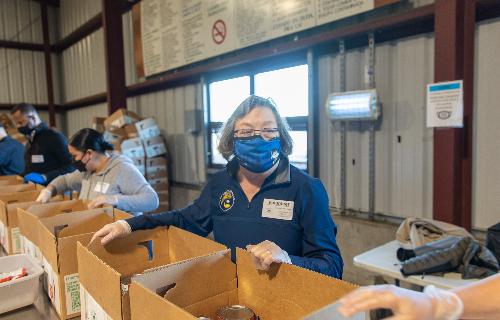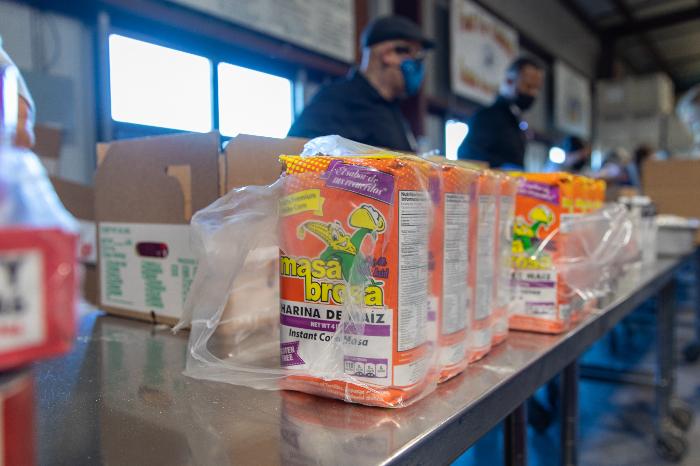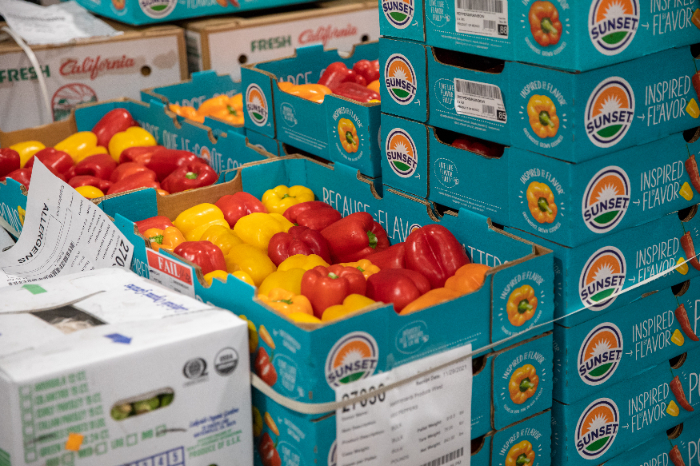The woman was in her late 60s and had worked all her life. But when her husband and her landlord each died within months of each other, the retiree found herself unable to find affordable housing and was living in her car. Thanks to Second Harvest Food Bank, food was the least of her worries. The woman was able to get a variety of healthy staples and vegetables each week as she tried to get back on her feet.
Unfortunately, her story is not unique in Santa Cruz County, according to Suzanne Willis, chief development officer at Second Harvest Food Bank. In a county known for its bucolic beaches and redwood forests, food insecurity is a very real problem.
Once again, UC Santa Cruz is stepping up to help.
Not only has the campus expanded its annual Second Harvest Holiday Food and Fund Drive—it now runs from Nov. 9 to Jan. 15—but a new format also allows faculty and staff to team up in order to help surpass last year’s donations of nearly $40,000 and make the drive more sustainable in years to come, according to its organizers.
“The people we’re seeing are bank tellers, grocery store checkers, wait staff, field workers, our neighbors,” said Second Harvest’s Willis, who has witnessed an increase in need. Pre-pandemic, the food bank provided food to 55,000 people per month, she said, with aid rising to 100,000 people each month during the height of COVID-19 restrictions in 2020. Now, the food bank is serving 75,000 people each month.
“If you are in a room with three people, look around,” said Willis, who noted one third of the county’s population is classified as being at risk of food insecurity. “One of them is probably barely making ends meet.”
The need in this community is very real,” said UC Santa Cruz Chancellor Cynthia Larive. “The pandemic, the CZU wildfires, and the economic turmoil of the past two years have been incredibly hard on so many people. I’m deeply proud of the work Second Harvest does, amazed at the incredible number of people the food bank is able to help, and thankful for all who donate to the annual drive. We are making a positive impact.”
Stretching dollars
The beauty of Second Harvest Food Bank, the second oldest food bank in the country, is its ability to stretch every dollar it receives, according to Nathan McCall, manager of UC Santa Cruz’s HR Business Information Services and chair of the Staff Advisory Board, which heads the campus’s Second Harvest drive.
Because Second Harvest has been in business for so long with a continuity of leadership, he said, it has built relationships that allow it to buy fresh produce for pennies on the dollar. For example, it can purchase a truckload of produce for $75.
“That’s how they can feed a family of four for $1,” McCall said.
A donation of $1,100 means that same family can eat for a year.
It’s why UC Santa Cruz has moved away from the traditional blue barrels that people used to fill with purchased food and toward an emphasis on monetary donations, McCall said. Donated money goes much further than contributed cans of soup and corn.
The campus also has extended the fund drive into January so that those who wish to donate in 2021 and 2022 can take a tax deduction both this year and next, McCall said. In addition, this year, groups on campus can work as sub-teams within the larger UC Santa Cruz campus—as Baskin Engineering and the Social Sciences Division are doing, for example. This allows groups “to harness energy around the local effort,” McCall said, and make fundraising more sustainable over the coming years for the whole of UC Santa Cruz.
Meanwhile, teams like Baskin Engineering are pioneering new partnerships with businesses in the community like Annieglass, he said. On Dec. 11, for instance, the store will donate 20 percent of its sales to Second Harvest on behalf of UC Santa Cruz. (See details below.)
A firsthand view
Mary Wells, who managed information systems for UC Santa Cruz’s University Relations Department until her retirement in 2007, has seen firsthand the help Second Harvest can provide. Named Hunger Fighter of the Year by Second Harvest Food Bank in 2020, Wells helps run a twice-weekly food pantry at Star of the Sea Catholic Church in Santa Cruz. Its clients, she said, include everyone from the disabled to the houseless to single mothers.
Each week about 100 people arrive at the church to receive food, the majority provided by Second Harvest, Wells said. The food not only includes basics like eggs and cereal but also plenty of fresh vegetables—some 60 percent of its offerings, according to the Second Harvest website. That makes Second Harvest one of “the healthiest food banks in the nation,” its website said.
The ability to collect and distribute food to places like food pantries and nonprofits is helped tremendously by donations from UC Santa Cruz, according to Willis.
It’s also important for the campus’s students.
Last year, for example, more than 31,000 pounds of food from Second Harvest were distributed to people living in Family Student Housing, while Slug Support handed out just over 61,000 pounds of food and the Student Union Assembly gave out about 27,000 pounds, according to McCall.
Said McCall of the campus’s Second Harvest drive: “I love to help people, and this is a very tangible way to do it. If you can donate a few bucks, it’s so easy to make a big, positive impact on people’s lives, thanks to Second Harvest’s network.”
To donate, visit the UCSC Holiday Food and Fund Drive team fundraising page.
Learn more about the Annieglass event.




